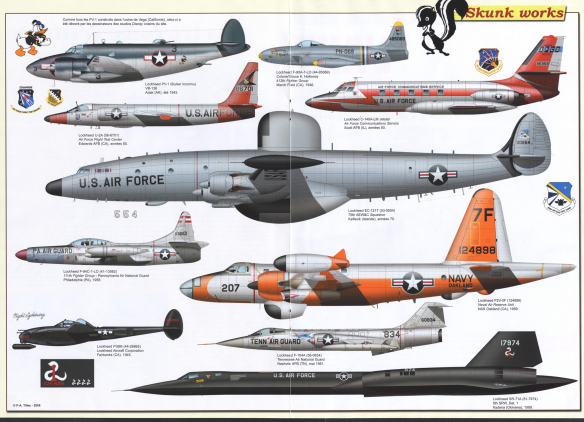By 1960, half of all U. S. federal government expenditures, or spending, went to the military and to the development of the latest military technology, including new aircraft, radar, ships, weapons, and electronic and telecommunication systems. The goal was to stay ahead of the Soviet Union in military might. Together, the U. S. military and the Department of Defense employed approximately 2.5 million people. The government contracted with large aerospace technology corporations, including Lockheed in Georgia and the San Francisco, California, area; Ling-Temco-Vaught (LTV) in Dalas–Fort Worth, Texas; Boeing in Seattle, Washington; and Mc-Donnell-Douglas and Hughes in southern California. These corporations employed tens of thousands of Americans. The partnership of military, defense, and industry came to be known as the military-industrial complex. This grouping reached out into a multitude of regions, touching a great number of American families. Large and small businesses subcontracted to provide materials needed by the military and aerospace industry. Universities throughout the nation received government contracts for technological research. The salaries people earned by this work allowed them to buy consumer goods, which in turn kept other companies, such as auto manufacturers, growing rapidly.
Clarence L.“Kelly” Johnson interviewed with Lockheed upon graduation in 1932, only to be told there were no jobs available. Advised to try again later, he went back to Michigan to earn a master’s degree. Going to work for Lockheed in 1933, he worked with chief engineer Hall Hibbard to redesign the Lockheed Electra, adding a twin tail for improved directional control. The redesigned Electra was a technical and commercial success, assuring Lockheed’s future.
After leading design teams for the Constellation transport and the P-38 Lightning fighter, Johnson teamed up with Hibbard again to build America’s first jet aircraft, the P-80 Shooting Star. The demands of this program led to the creation of Lockheed’s fabled Skunk Works, an experimental group under Johnson’s direct supervision, where designers and workers could cooperate closely and red tape was eliminated. Here Kelly found his niche, revealing himself to be a brilliant manager as well as engineer. Intense, driven, and to- tally devoted to the job, he inspired his people to achieve much more than they might have in a more relaxed atmosphere. Johnson’s leadership led to the completion of a prototype aircraft in an incredible 143 days from the signing of the initial contract.
After the war, Lockheed’s Kelly Johnson became a legend by developing such aircraft as the U-2 and SR-71. The main production programs were not the fighters and spyplanes built in Burbank and Palmdale but featured the large military transports built in Marietta, Georgia. The Lockheed Missiles and Space subsidiary developed all of the U. S. sub- marine-launched ballistic missiles (Polaris, Poseidon, and Trident), as well as most of the spy satellites between 1960 and 1999. Other subsidiaries produced electronic warfare equipment, managed the processing and launching of the Space Shuttle, and supported the Department of Energy. Lockheed merged with Martin Marietta in 1995, creating the Lockheed Martin Corporation. In October 2001, Lockheed Martin was awarded the largest U. S. defense contract in history—worth some $200 billion—to manufacture the Joint Strike Fighter.
U-2 Spy Flights.
Utility 2 was the code name for the secret American spy plane. Between 1956 and 1960 the United States learned much about military activities in the U. S. S. R. and its satellites from U-2 photography flights. In 1950 the U. S. Strategic Air Command (SAC) began unauthorized espionage flights over the U. S. S. R., using modified B-29 bombers, until President Harry Truman (1884–1972) found out, and banned them. In 1956, when Dwight D. Eisenhower (1890–1969) was President, Lockheed U-2 reconnaissance jet planes were readily available for espionage. They were single-seated, high-altitude aircraft that flew at 75,000 feet, well away from Soviet missiles and fighters. Cameras on these planes could photograph everything the U. S. military needed.
In June 1956, U-2 flights over the Soviet Union began again, and from 90,000 feet Russian installations were photographed clearly. In 1957 photographs showed a Russian ICBM had been developed. It was tested in May and failed; another succeeded in August and flew 3,500 nautical miles. U-2 spy plane photos appeared to indicate considerable growth in Soviet military capability. It seemed a race was on between the Russians and the West to secure the most powerful way to deliver nuclear weapons against an enemy. Russia had intercontinental missiles by May 1957.
In 1958, President Eisenhower established the National Aeronautics and Space Administration, and some Pentagon funds were directed to producing a satellite that would replace the secret U-2 espionage flights. By the end of 1959, the U. S. S. R. had launched 40 missiles. Early in April 1960, Eisenhower authorized a resumption of the U-2 spy plane project, and a U-2 flight photographed what appeared to be four ICBMs. In May 1960 a U-2 spy plane was shot down over Soviet territory. Immediately, the National Security Agency denied it was conducting U-2 flights over the Soviet Union, though in fact it had been doing so for four years. Nikita Khrushchev (1894–1971) produced the pilot, Francis Gary Powers (1929–1977), with cameras and all the technology of high- altitude espionage. U-2 cameras could, from 13 miles up, show the license plate number of an automobile in the street, and with later techniques could detect the make of the vehicle. Russian militia were observed in Cuba, and U-2 flights showed that in August 1962 there was clear evidence of sites for surface-to-air-missile batteries. By October 14, 1962, it was evident from U-2 flight photographs that special ICBM launchers were among palm trees that partly concealed equipment normally found with ballistic missiles. U-2 flights established that the Russians were putting ICBMs into Cuba, and the Cuban Missile Crisis began that month.
